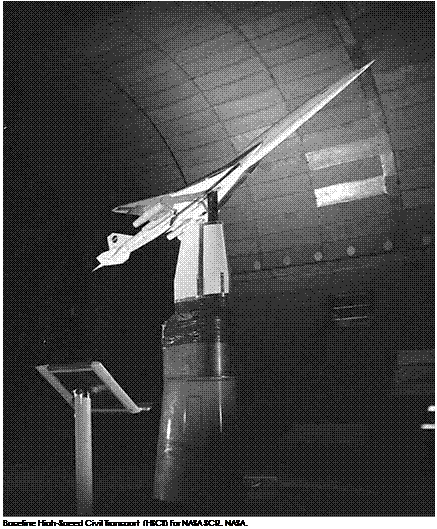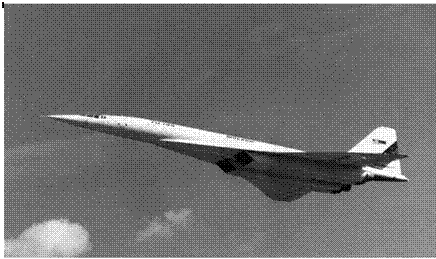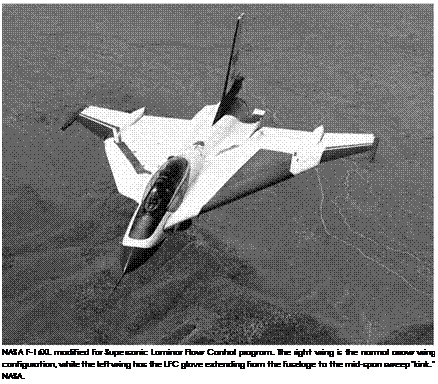Supersonic Cruise in the 1990s: SCR, Tu-144LL, F-16XL, and SR-71
![]() NASA essentially resumed in 1990 what had ended in 1981 with the termination of the SCR program. Enough time had elapsed since the U. S. SST political firestorm to suggest the possibility of developing a practical aircraft.[1108] Ironically, one of the justifications was concern that not only the Europeans but also the Japanese were studying a second – generation SST, one that could exploit reduced travel times to the Pacific rim countries, where U. S. overland sonic boom restrictions would not be such an economic handicap. A Presidential finding in 1986 during the Reagan Administration stated that research toward a supersonic commercial aircraft should be conducted. A consortium of NASA Research Centers continued research in conjunction with airframe manufacturers to work toward development of a High-Speed Civil Transport (HSCT), which would essentially become the 21st century SST. The development would incorporate lessons learned from previous SSTs and research conducted since 1981 and would be environmentally friendly. A test concept aircraft (TCA) configuration was established as a baseline for technology development studies. Cruise Mach number was to be Mach 2 to 2.5, and design range was to be 5,000 nautical miles, in deference to the Pacific Ocean traffic. Phase I of the SCR was to last 6 years, while concentrating on such environmental issues as studies on ozone layer impact of an SST fleet and sideline community noise levels. Both areas required extensive propulsion system studies and probable advances in engine technology. Studies of the economics of an HSCT showed that the concept would be more practical if there were a reduction of a sonic boom footprint to the point where overland flight was permissible in some corridors. The Concorde boom average was 2 pounds per square foot, which was deemed unacceptable; the questions were what would be acceptable and how to achieve that level. Phase II was to be focused on development of specific technologies leading to HSCT as a practical commercial aircraft. The initial goal was for a 2006 development decision target date.
NASA essentially resumed in 1990 what had ended in 1981 with the termination of the SCR program. Enough time had elapsed since the U. S. SST political firestorm to suggest the possibility of developing a practical aircraft.[1108] Ironically, one of the justifications was concern that not only the Europeans but also the Japanese were studying a second – generation SST, one that could exploit reduced travel times to the Pacific rim countries, where U. S. overland sonic boom restrictions would not be such an economic handicap. A Presidential finding in 1986 during the Reagan Administration stated that research toward a supersonic commercial aircraft should be conducted. A consortium of NASA Research Centers continued research in conjunction with airframe manufacturers to work toward development of a High-Speed Civil Transport (HSCT), which would essentially become the 21st century SST. The development would incorporate lessons learned from previous SSTs and research conducted since 1981 and would be environmentally friendly. A test concept aircraft (TCA) configuration was established as a baseline for technology development studies. Cruise Mach number was to be Mach 2 to 2.5, and design range was to be 5,000 nautical miles, in deference to the Pacific Ocean traffic. Phase I of the SCR was to last 6 years, while concentrating on such environmental issues as studies on ozone layer impact of an SST fleet and sideline community noise levels. Both areas required extensive propulsion system studies and probable advances in engine technology. Studies of the economics of an HSCT showed that the concept would be more practical if there were a reduction of a sonic boom footprint to the point where overland flight was permissible in some corridors. The Concorde boom average was 2 pounds per square foot, which was deemed unacceptable; the questions were what would be acceptable and how to achieve that level. Phase II was to be focused on development of specific technologies leading to HSCT as a practical commercial aircraft. The initial goal was for a 2006 development decision target date.
The digital revolution has had a major impact on supersonic technology. The nonlinear physics of supersonic flow shock waves made control of a system difficult. But the advent of high-speed computer technology changed that. The improvement in the SR-71 fleet performance shown by the DAFICS, pioneered by NASA in the YF-12 program, showed the
 |
|
operational benefits of digital controls. But in SCR, much effort centered on using the computational fluid dynamics (CFD) codes being developed to perform design tasks that traditionally required massive wind tunnel testing.[1109] CFD could also be used to predict sonic boom propagation for configurations, once the basic physics of that propagation was better
 |
|
understood. Another case study in this book addresses the details of the research that was conducted to provide that data. Flight tests included flights by an SR-71 over an instrumented ground array of microphones as in the 1960s that were also accompanied by instrumented chase aircraft that recorded the shock wave characteristics in free space at various distances from the supersonic aircraft. These data were to be used to develop and validate the CFD predictions, just as supersonic flight-test data has traditionally been used to validate supersonic wind tunnel predictions.
Another flight research program devoted to SCR included a post-Cold War cooperative venture with Russia’s Central Institute of Aerohydromechanics (TsAGI) to resurrect and fly the Tu-144 SST of the 1970s.[1110] Equipped with new engines with more powerful turbofans, the Tu-144LL (the modified designation reflecting the Cyrillic abbreviation for flying laboratory) flew a 2-phase, 26-flight-test program in 1998 and 1999 at cruise Mach numbers to 2.15. All the flights were flown from Zhukovsky Flight Research Center outside Moscow, and NASA pilots flew on 3 of the sorties.[1111] Experiments investigated handling qualities, boundary layer characteristics, ground cushion effects of the large delta wing, cabin aerodynamic noise, and sideline engine noise.
 |
|
Another flight research program of the 1990s was the NASA use of the arrow wing F-16XL. Flown over 13 months in 1995-1996, the 90-hour, 45-flight-test program was known as the Supersonic Laminar Flow Control program.[1112] A glove was fitted over the left wing of the aircraft, which had millions of microscopic laser-drilled holes. A suction system drew the turbulent supersonic boundary layer through the holes to attempt to create a laminar boundary layer with less friction drag. Flight Mach numbers up to Mach 2 showed that the concept was indeed effective at creating laminar flow. This was a significant finding for an HSCT, for which drag reduction at cruise conditions is so critical.[1113]
The USAF had taken the SR-71 fleet out of service in 1990 because of cost concerns and opinions that its reconnaissance mission could be
better accomplished by other platforms, including satellites. This freed a number of Mach 3 cruise platforms equipped with advanced digital control systems for possible use by NASA in the SCR effort. Dryden Flight Research Center was allocated two SR-71As for research use and the sole SR-71B airframe for pilot checkout training. The crewtraining simulator was also installed at Dryden. It was being updated to new computer technology when the financial ax fell yet again. Some research relevant to supersonic cruise was performed on the SR-71s. Handling qualities and cruise performance using the updated configuration were evaluated. Despite the digital system, the use of an inertial vertical velocity indicator at Mach 3 was still found to be superior to the air-data-driven vertical velocity for precise altitude control.[1114] An experimental air-data system using lasers to sense angle of attack and sideslip rather than differential air pressure was also tested to confirm that it would function at the 80,000-foot cruise altitude. Several Sonic Boom Research Program flights were flown, as mentioned earlier, for in-flight sonic boom shock wave measurements. The SR-71 had to slow and descend from its normal cruise levels to accommodate the instrumented chase aircraft. Like the YF-12, the SR-71 was again used as a platform for experiments. Several devices planned for satellite Earth observations were carried in the sensor bays of the SR-71 for observations from above 95 percent of the Earth’s atmosphere. An ultraviolet camera funded by the Jet Propulsion Laboratory conducted celestial observations from the same vantage point.
![]() The program that mainly funded retention of the airplanes was actually in support of a proposed (later canceled) reuseable space launch vehicle, the Lockheed-Martin X-33. It would employ a revolutionary rocket engine, the Linear Aerospike Rocket Engine (LASRE). The engine used shock waves to contain the exhaust and increase thrust at a comparatively light structural weight. For risk reduction, the SR-71 would have a fixture mounted atop the fuselage, on which would be installed a 12-percent model of the X-33 with engine for aerial tests. The fixture was installed, but the increased drag of the fixture plus the LASRE limited the maximum Mach number attainable to around Mach 2. The installation was carried on several flights, but insuperable flight safety issues
The program that mainly funded retention of the airplanes was actually in support of a proposed (later canceled) reuseable space launch vehicle, the Lockheed-Martin X-33. It would employ a revolutionary rocket engine, the Linear Aerospike Rocket Engine (LASRE). The engine used shock waves to contain the exhaust and increase thrust at a comparatively light structural weight. For risk reduction, the SR-71 would have a fixture mounted atop the fuselage, on which would be installed a 12-percent model of the X-33 with engine for aerial tests. The fixture was installed, but the increased drag of the fixture plus the LASRE limited the maximum Mach number attainable to around Mach 2. The installation was carried on several flights, but insuperable flight safety issues
meant that the engine never was fired on the aircraft.[1115] Funding ended with the demise of the SCR program. The final flight of the world’s only Mach 3 supersonic cruise fleet occurred as an overflight of the Edwards Air Force Base Open House on October 9, 1999. The staff of the Russian Test Pilot School furnished an indication of the unique cachet of the aircraft when they visited the USAF Test Pilot School at Edwards as part of a reciprocal exchange in the mid-1990s. They had earlier hosted the Americans in Moscow and allowed them to fly current Russian fighters. When asked what they would like to fly at Edwards, the response was the SR-71. T hey were told that was unfortunately impossible because of cost and because the SR was a NASA asset, but that a simulator flight might be arranged. Even so, these experienced test pilots welcomed the opportunity to sample the SR-71 simulator.
![]() By 1999, much research work had been performed in support of the HSCT.[1116] Nevertheless, no breakthrough seemed to have been made that answered all the issues raised on a practical HSCT development decision. One of the major contractor contributors had been McDonnell – Douglas, which became Boeing in the defense industry implosion of the 1990s.[1117] In 1999, Boeing withdrew further major financial support, as it saw no possibility of an HSCT before 2020. Also in 1999, NASA Administrator Daniel S. Goldin cut $600 million from the aeronautics budget to provide support for the International Space Station. These two actions essentially ended the SCR for the time being.
By 1999, much research work had been performed in support of the HSCT.[1116] Nevertheless, no breakthrough seemed to have been made that answered all the issues raised on a practical HSCT development decision. One of the major contractor contributors had been McDonnell – Douglas, which became Boeing in the defense industry implosion of the 1990s.[1117] In 1999, Boeing withdrew further major financial support, as it saw no possibility of an HSCT before 2020. Also in 1999, NASA Administrator Daniel S. Goldin cut $600 million from the aeronautics budget to provide support for the International Space Station. These two actions essentially ended the SCR for the time being.










